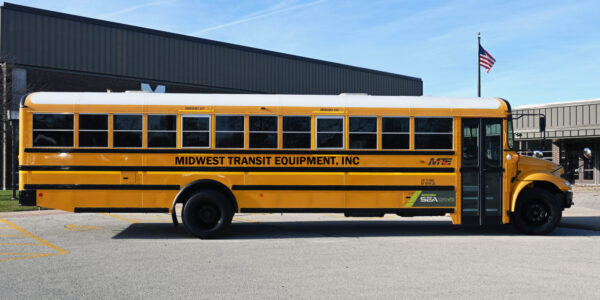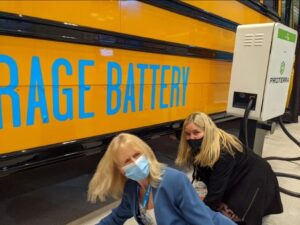The Money Cannon for Electric School Buses

At a recent school bus conference Jackie Piero of Nuvve noted, “There is a money cannon getting ready to be shot out of Washington D.C. for electric school buses” (ESB’s)” Federal ESB funding, along with how equity and raising up disadvantaged communities should, and probably will, be central to how this funding is administered nationwide.
The U.S. Environmental Protection Agency (EPA) is in charge of administering the $5 billion of the the Bipartisan Infrastructure Bill dedicated to cleaner school buses, 2.5 billion specifically for electric school buses and the other 2.5 billion for alternatively fueled school buses, including electric, propane and more. Eligible recipients for funding: state and local governments, certain contractors, nonprofit school transportation associations, and Tribes, Tribal organizations or Tribally-controlled schools.
The EPA recently held a listing session where they shared where the program is now, and provided opportunity for folks to share feedback. The recording is available at epa.gov/cleanschoolbus. If you have feedback on how to make this program a success, send your written input to cleanschoolbus@epa.gov.
For example: should funds be awarded by formula, according to districts’ needs and their existing air quality? Or competitively awarded, which would favor richer districts that have more resources and experience in grant writing? Should funding include some staffing implementation costs, especially for low income districts already strapped for staff? (Knowing that implementation can be hard and time-consuming, I think yes, on the basis of equity.) How about point of purchase vouchers for ESB’s and charging infrastructure (EVSE), where districts would receive the funds at time of purchase?

The Jouley, Thomas Built’s electric bus, with a Proterra charger to the right, at the STN Conference/Expo in Reno, Nevada last week. From right, Lisa Lillelund of Proterra, which makes the Jouley’s drivetrain, and Alison Wiley of the Electric Bus Newsletter. Blue lettering refers to Storage Battery, not Rage Battery. Photo by Michelle Levinson.
Key Players in the New Funding (in no particular order):
Alliance For Electric School Buses (AESB), formerly called the Electric School Bus Coalition, is an advocacy alliance of almost 30 nonprofits, active in this space long before it became funded, or profitable to companies. Led by Chispa, alliance members include Mothers Out Front, Sierra Club, Environmental Law and Policy Center, Clean Energy Works, U.S. PIRG, Jobs To Move America, this newsletter and many more. As I’ve noted before, the children who most depend on school buses are disproportionately low income and disadvantaged. These communities breathe the worst air, with the worst health outcomes, while having the least access to health care. ESB’s improve children’s health, school attendance and life opportunities, and also the climate we all share. I think the AESB will help guide the EPA to an equity-focused program, and so will the federal government’s Justice40 Initiative.
Highland, a for-profit financing company with a strong energy background, contracts with school districts to help them electrify their school bus fleets. Like SEA Electric (below), it has stated it will be eligible for EPA’s Clean Bus funding, i.e., to form public/private partnerships. Highland leverages funds, investing in the fuel and maintenance savings of ESB’s that will accrue over the years, and the energy services for utilities that ESB’s will, they trust in future, provide when they’re not being driven, such as vehicle to grid (V2G) services. Highland guarantees a district no costs above their current operating costs as they add electric buses, and flattens their ESB purchase costs to their usual, i.e. diesel, costs. Highland’s largest customer so far is Montgomery County in Maryland; their 1,400 bus fleet is now slated to become fully electric by 2035. A Highland spokesperson told me their contracts guarantee that the ESB’s they finance will fulfill all their transportation responsibilities before they fulfill any energy responsibilities, such as V2G discharges into the utility grid. (To be honest, I’ve long worried about conflicts of interest between kids’ needs and utilities’ needs; sounds like they’re being addressed, at least in the way Highland writes contracts.) Learn More
SEA Electric, recently landed funding from Midwest Transit Equipment to convert the drivetrains of 10,000 fossil-fueled school buses to electric. I interviewed Tony Fairweather, CEO and founder, and learned from him that school districts will be able to buy his company’s repowered buses with the EPA funding. “At $150,000-$175,000, we can do two or three repowers for the cost of a new electric school bus. We are brand-agnostic and fuel-agnostic; we’re talking with all the OEM’s, and it doesn’t matter what fuel type the bus is, we can repower it. ” Learn More
I wondered aloudwhether SEA and its repowering model could partner with Highland and its financing model to stretch funds and sharply accelerate electrification of school bus fleets? Both Tony Fairweather and Mike Menyart, SEA’s Chief Strategy Officer and President of the Americas, told me yes, they’re already looking at that idea.
World Resources Institute’s Electric School Bus Initiative, funded by 30 million from the Bezos Earth Fund, is new on the scene, yet clearly a player. It is working on market transformation through research, advocacy and relationships with EPA, utilities, OEM’s, the Alliance For Electric School Buses and many more organizations. WRI does not fund buses or infrastructure. It works to build capacity, and it supplies funding to a variety of organizations. Learn More
Everywhere I turn there are more smart people with more valuable, late-breaking information that I would love to share. We look forward to sharing more information about the Clean School Bus program as the details pour out.
If you haven’t already please consider joining our newsletter to get up to date information on school bus electrification.